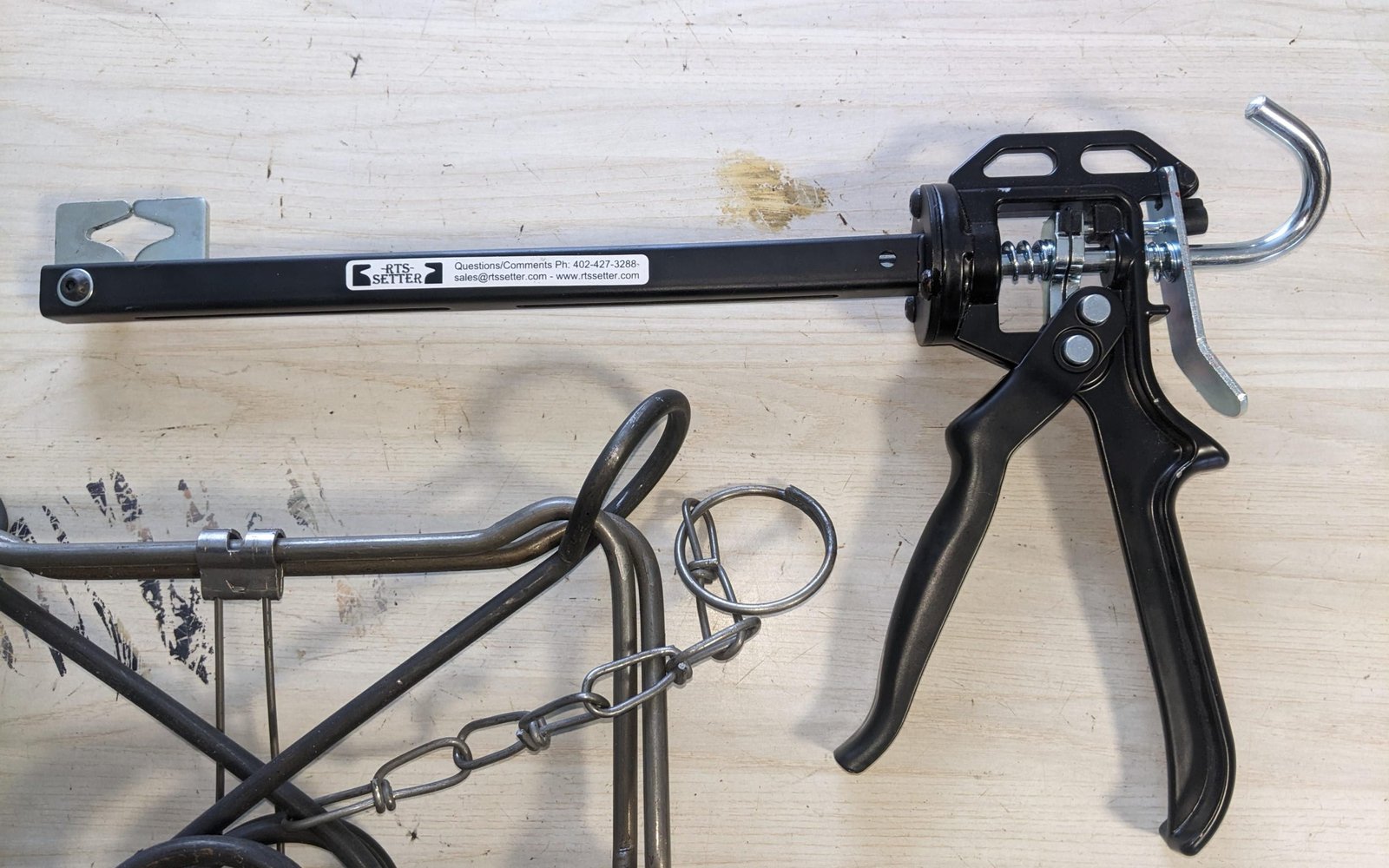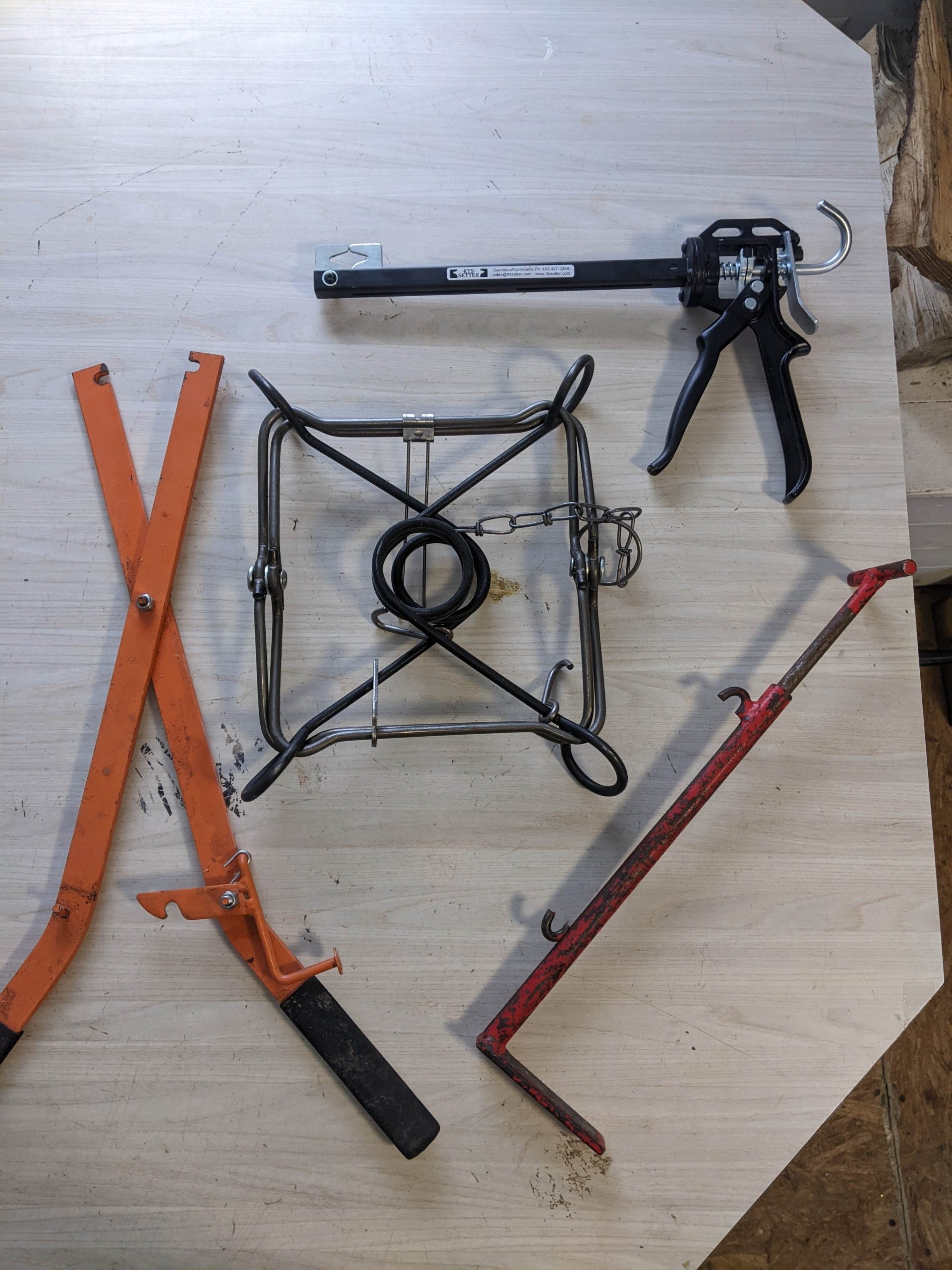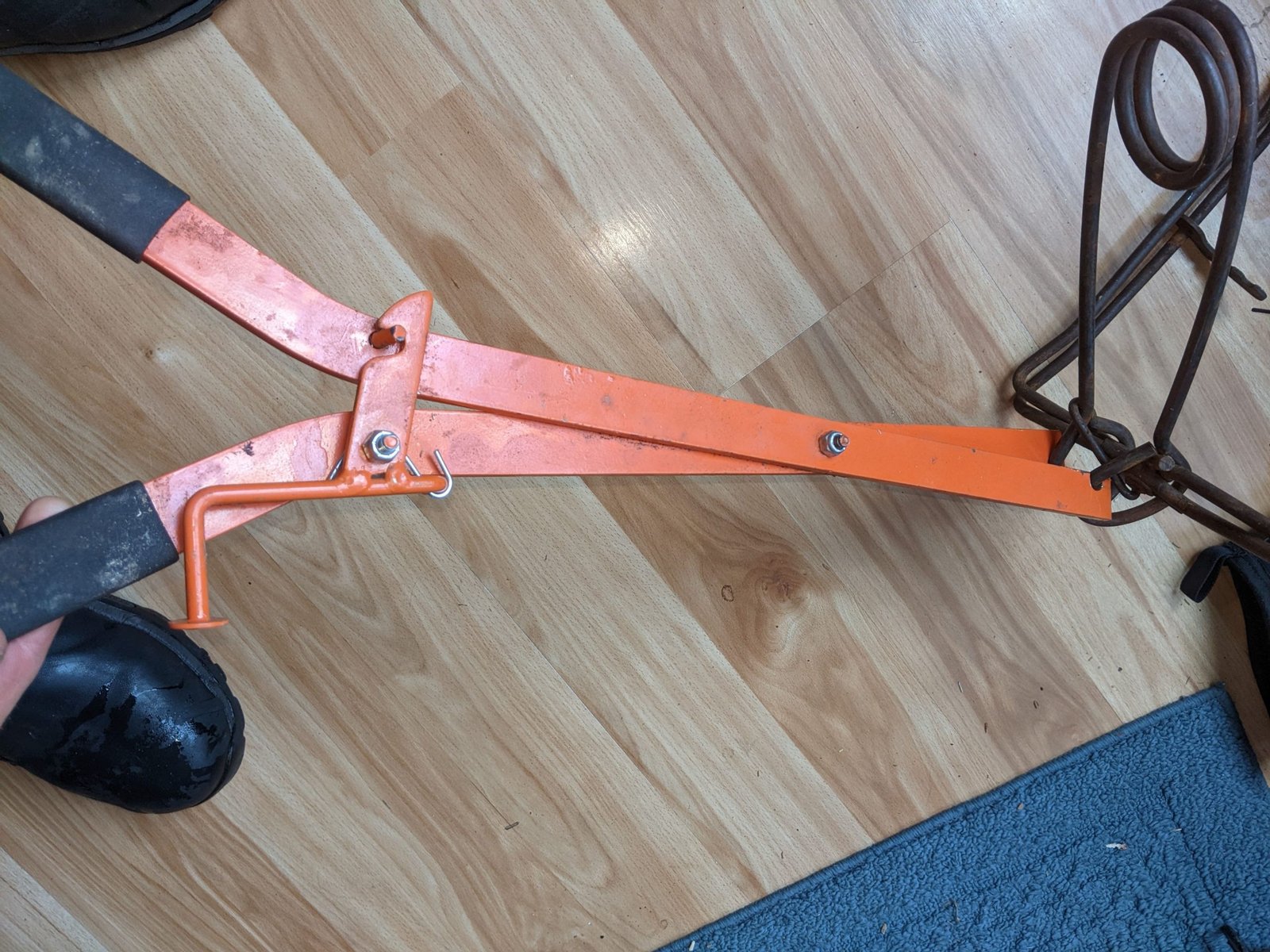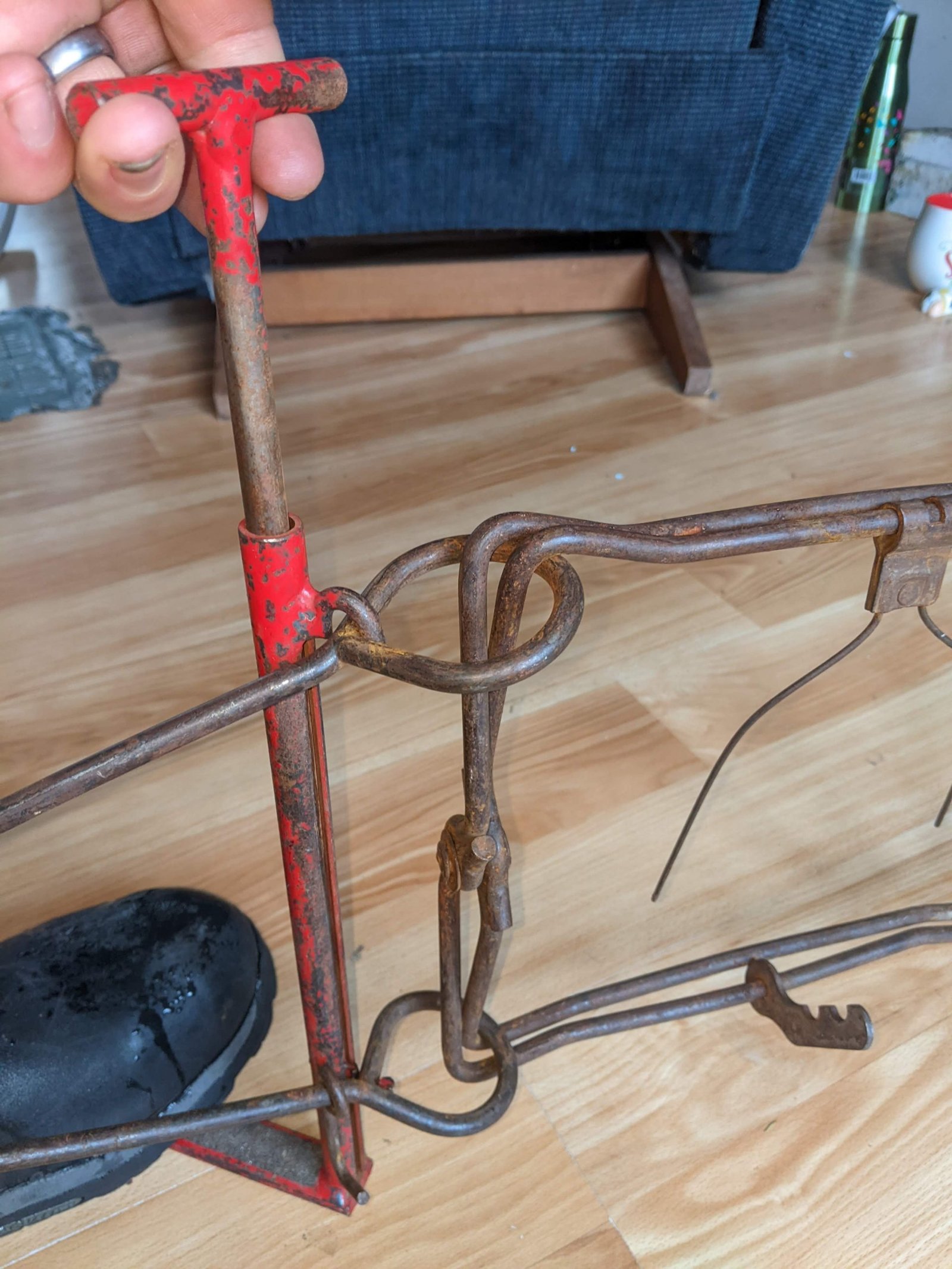This site is supported by you, the reader. If you make a purchase through one of my links, I may earn a small commission. Learn more here.
If you’re setting a bodygrip trap for the first time, without tools, you may find yourself in quite a dilemma. Sure, setting smaller traps like the 110 or 120 sized bodygrips can be done by hand, but once you get into the larger traps – 160, 220 and 330 size, you really need a tool. A few super strong folks may be able to set the larger conibears by hand, but doing so with a large number of traps without completely wearing out your body ain’t gonna happen!
Trap setting tools come in a variety of shapes and sizes, and range widely in quality and price accordingly. But the basic use of any tool is simply to compress the springs on the trap so that you can open the jaws and set the trigger by hand. Bodygrip traps that have two springs have safety catches that are used to hold the spring shut. Basic operation when setting these is to use a tool to compress each spring and engage the safety catches, then open the jaws by hand and set the trigger/dog without having to work against the impossible leverage of uncompressed springs. For lack of any official terminology, I’ll describe the three main styles of setters as: 1)chain/rope, 2)scissor type, 3)step and pull, and 4)hand ratchet.
Chain/Rope
Many people may not realize that you can set bodygrip or Conibear traps with a rope. By properly wrapping a rope (with a loop on one end) through the spring eyes of a trap, you can cause the springs to compress by pulling the rope. This is great in an emergency, and many trappers carry a special rope with them just incase, but it isn’t an efficient way to set large numbers of traps. Working on the same principal, you can actually purchase chain-type setters to compress springs. These have a hook on one end and a handle on the other, and can be a good option either for safety or when going long distances on foot where carrying weight is an issue.
Scissor Type
The scissor-type bodygrip trap setters are the most common you’ll see in the trapping supply market, and they range considerably in quality and functionality. You use these to compress trap springs by hooking the tongs on the business end to each trap spring eye, and use the leverage of the long handles to compress the spring by squeezing the handles together.
The most basic – and cheapest – setting tool is the kind you’ll see at the hardware store that sells traps, or the lowest price setter in the trapping supply catalogs or websites. It’s simply two pieces of steel bolted together at a hinge point and a couple grooves on one end to set over the trap springs. This is the ideal tool for the homeowner or farmer who only needs to set a couple of traps to take care of some problem beaver, raccoon or similar pest. It also works for the beginner trapper, but over time, you’ll learn that it has major shortcomings. Basically, this design is cheap and effective, but not designed for long term or heavy use. You also have to be really careful in using it to set traps, as there is no safety latch to release the pressure on the handles when you’ve compressed a spring. Some improvements to this design include aluminum or high quality steel construction (which keeps the levers from bending when using strong-springed traps or long term use), a higher quality hinge point, better spring notches and ergonomic handles to make setting easier.
The advanced version of the scissor-type setting tool, and the most critical part in my opinion, is that they include a spring loaded self-locking latch that engages when the trap spring is compressed, releasing pressure from the handles so that you can set the spring safety catch without maintaining pressure on the setters. Anyone who’s used those entry level setters can attest that you almost need a third hand to be able to get the safeties on the springs while the springs are compressed. In fact, I used to compress the springs with both hands, then rest one handle on my leg, the ground or the tailgate of the truck to free one hand to work the trap safety. This is dangerous, as the levers can pop open and strike you if you aren’t careful. With these more advanced setters you can compress the spring and allow the latch to engage, holding the levers closed, while you use your free hand to put the spring safety in place. It’s more convenient and much safer. These type of setters are very commonly used among experienced trappers and animal damage control agents everywhere. Note: As I write this, it’s very difficult to find these type of setters – they seem to be out of stock most everywhere I’ve checked. If you can find a pair, don’t hesitate to get it!
Step and Pull
The step-and-pull setter design is an ingenious adaptation that allows you to set traps with one hand and one foot, eliminating that ‘need for a third hand’ issue. This tool is commonly sold under the name GEM (click here to find one). As a young trapper I graduated from the entry level setters to these after seeing them at a trapping convention. The tool is basically two metal rods, one inside the other, with a foot step on one end and a handle on the other. Each rod has a hook welded on it to attach to the trap spring eyes. It’s a little less convenient to set with this tool because the foot step has to be sitting on the ground or a solid object. You step down on it, position the trap so that the spring eyes line up with the hooks, and simply pull the handle upward to compress the trap spring. With your free hand you can flip the safety catch on the spring. As a youngster I found this much easier to use than the conventional setters because you’re using your entire body rather than your upper arms. However, it can be a bit awkward to find solid ground and get the trap in the right position every time you compress a spring. If you have a bad back, you probably don’t want to use these as they require lots of bending at the waist.
Hand Ratchet

The main types of bodygrip trap setters remained unchanged for many years, until a new innovation came along and changed the game. The RTS trap setter is built like a heavy duty caulking gun, and works the same way. Two pieces of steel with notches to hook onto trap springs are compressed together via simple compression of a handle. While a bit slower operating than a conventional trap setting tool, the RTS is physically the easiest setter to use. It can be operated with one hand, requires very little force (just some simple hand squeezes) and can be used in any position. The notches can be hooked anywhere on the spring, not just the spring eyes. The ratcheting action of the setter serves as a built-in safety device as well. These are expensive setters, but to me they’re the safest, most ergonomic, and highest quality option.
| Photo | Title | Price | Buy |
|---|---|---|---|

|
Heavy Duty Body Grip Trap Setter - Sets 110 to 330 Body Grip Traps with 1 Hand | $82.95 |

|
Regardless of the tool you choose, it’s good to know there is a variety of options for setting bodygrip traps. Some people, like myself, find that owning several different styles allows for flexibility in different situations. And as a bonus, many of these setters will work on long spring traps too.









[…] strength and design can present a safety problem for the person setting them. Be sure to use the proper setting tools and safe practices to use these traps wisely and avoid […]